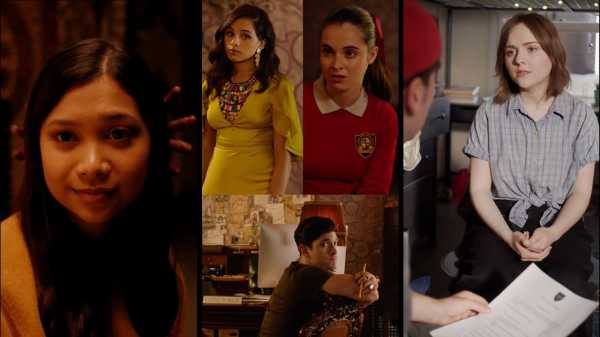
As long as critics are lifting their year-end songs of praise, I’d like to propose that the most formally inventive episode of television in 2018 was the fifth installment of “Co-Ed,” which consists of one long scene of a young woman silently sitting with her phone. The character, Vita (Lucy Barrett), sends a deceptive text message to her long-distance sort-of girlfriend, Ginny (Tara Lynne Barr), then thumbs through their archive of exchanges. Vita smiles as she bathes in the message bubbles of their early relationship and sours upon encountering a pivotal moment of complication. This epistolary vignette unfolds for three minutes, ends on a note of messy emotion, and in the next instant the sixth episode is playing. “Co-Ed” streams on the social-media app Snapchat. It’s a Snap Original—the sharpest of a new breed of micro-series.
Generally, social media has made uncertain progress toward colonizing older forms of screen entertainment, and Snapchat stands out for delivering shows organic to its medium in form and tone. Though Facebook Watch offers many flavors of television, even those programs center on personalities nurtured by the Internet—a reality show about the beauty blogger Huda Kattan, for instance—aren’t especially Internet-ish or social-media-savvy. Its first critical hit, the bereavement drama “Sorry for Your Loss,” was originally developed at Showtime and retains its prestige-TV shape; its reality shows, which include “Big Chicken Shaq,” about Shaquille O’Neal’s jovial adventures as a restaurateur, closely resemble the staple meals of basic cable.
Meanwhile, the current issue of Fast Company includes a story headlined with a disappointed query: “Instagram’s IGTV was supposed to be the ‘next generation’s TV-viewing experience.’ What happened?” IGTV, which launched in June, has been most notable as a venue for brands to distribute odd-sized commercials and curiosities. NBC presents, for no good reason, condensed episodes of the bygone sitcom “Saved by the Bell.” Nike just does two-minute profiles of amateur athletes, crisply cinematic and generically inspirational. At Thanksgiving, Netflix uploaded a jokily leering hour of the actor Gavin Leatherwood, of “The Chilling Adventures of Sabrina,” preparing Thanksgiving dinner. “I hope you like your turkey moist,” he says, in a come-hither tone, above sultry music.
But Snap Originals like “Co-Ed” are proper attempts to translate TV programming into a new-media language. Even when trashy or trifling, they’re an earnest experiment in styling serial narratives that alternately pander to Generation Z and endeavor to address its sensibilities with respect.
The least august of the Snap Originals is also, apparently, the most successful—“Phone Swap,” ritually introduced by an unseen host who asks, “Would you let someone look through your phone on a first date?” The thing is so simple in its premise and primal in its effects as to approach conceptual perfection. A blind date. Each remotely watches the other sift through the digital residue of her ego and id. The couple reconvenes to determine whether it would be sketchy to consider a second date. A majority of the episodes share the same click-bait title, “Can You Watch THIS Without Cringing?”; a few bear names along the lines of “Found it! The Nudes Are Right There.” Each installment reportedly garners ten million viewers.
The genre fictions on Snapchat are stripped down to the essentials, structured for immediate impact, and configured for vertical viewing, with a lot of closeups and, occasionally, stacked split screens that catch the same tableau from two different angles. Even when ludicrous, they are studies in narrative efficiency. “V/H/S” is a mildly spooky anthology series derived from the 2012 found-footage horror film of the same title. The first episode typifies the structural conceit: a teen-ager will not close her phone’s camera app, even to call 911, despite the fact that supernatural mayhem is slimily spoiling a slumber party. “Class of Lies” moves ahead in jump cuts that feel like sharp glides, as if the show is swiping forward to the next scene, as a pair of college students rescue a friend who went missing after a frat party. The sleuths rely on instincts that they honed as hosts of a true-crime podcast, and on their STEM skills. Now and then, the empirical formulas for chemical compounds—the ingredients for a home-brew forensic-science emulsion, say—will pop up onscreen, a curious but typical choice. This lurid melodrama is a bombardment of hectic incident data, anxious feeling, and random data. Eager to earn the viewer’s attention, it threatens to overwhelm it.
A similar freneticism propels “The Dead Girls Detective Agency.” Here, within the first thirty seconds, the heroine has been fatally shoved in front of a subway train. She reappears in a well-appointed purgatory, where her peers briskly explain that she must solve her own murder if she hopes to rest her soul. There’s a dizziness to its fun pileup of teen-soap intrigues involving fake I.D.s and fake friends. Given the brevity of the episodes and the quickness of the pace, we are always at the edge of a cliffhanger.
Each of the Snap Originals incorporates the smartphone into its narrative and visual schemes. Even “Phone Swap” features a graphic imitating the typing awareness indicator; this pulsating ellipsis underlines subtitles, where it stirs excitement and dread. The approach of “Co-Ed,” unsubtle but sensitive, suits its substance as a coming-of-age relationship drama. (It was written and directed by Mason Flink, with producers including Mark and Jay Duplass, and you might define its genre as upspeak mumblecore.) The brilliance of that fifth episode, titled “Would You Lie to Your BFF?”, is in how it moves the story forward by filling in backstory, how the review of old speech acts supplies a fresh approach to action. Elsewhere, Flink arranges scenes of video chats to place the viewer behind the characters’ eyes—an illusion in the service of empathy.
Sourse: newyorker.com






